September 3rd, 2013 §
What happened to those damp little fuzzballs? Nothing remains of the chicks but their little peeping noises, which they still make when they aren’t busy practicing being grown-ups, crowing, and mating their siblings.
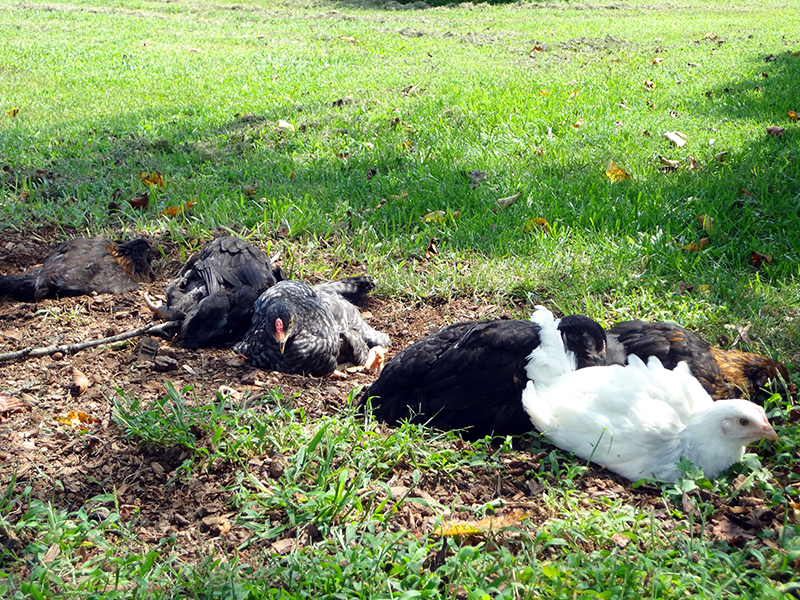
The chicks are now eight weeks old, and they are miniature chickens in most regards. This week I’ve let them find their own way out of their brooder coop and out of the garage into the wild world. They stick close to the bushes, dust bathing for hours in mulch, but each day they venture a bit further from their comfort zone. It’s wonderful to watch.
It looks like I have two cockerels: Griz, Oregano’s baby, and a Black Copper Marans/Wheaten Ameraucana mix. One thing I’ve really noticed is how much more flighty the chicks with the Black Copper Marans blood are. Makes sense, as their parent hens are the least docile of all my birds. Here’s the BCM/Wheaten Ameraucana cockerel, in front, with Griz behind, then the pretty black pullet hatched from Lilac’s egg, and finally a BCM/Wheaten Ameraucana pullet in back.
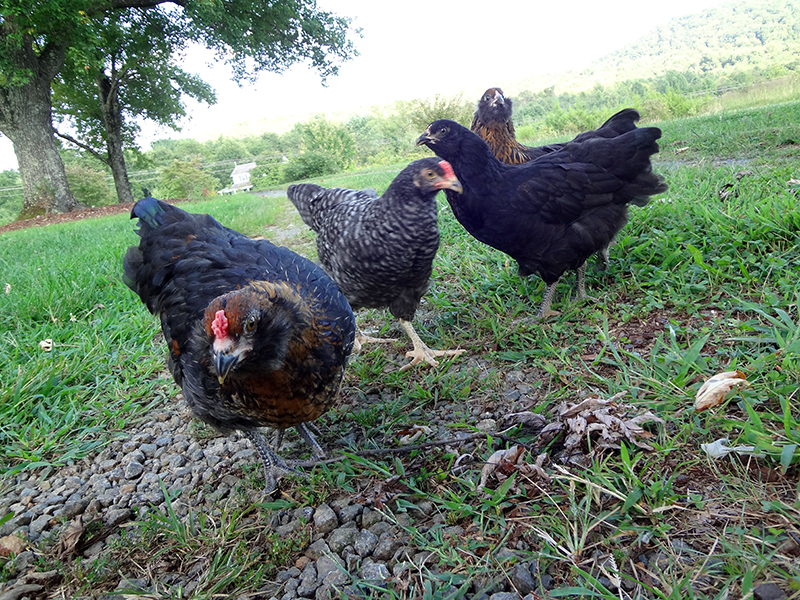
The homegrown birds all, except for Griz, have the cute facial feather tufting that comes along with their Wheaten Ameraucana blood. Interestingly, even though Griz’s father is a Wheaten Ameraucaua, he does not exhibit this feathering. Instead he looks like a straight-up Cuckoo Marans, which is blood that came from his mother’s line. So interesting to see genetics in action. Meanwhile, Griz learns just how palatable slippers are.
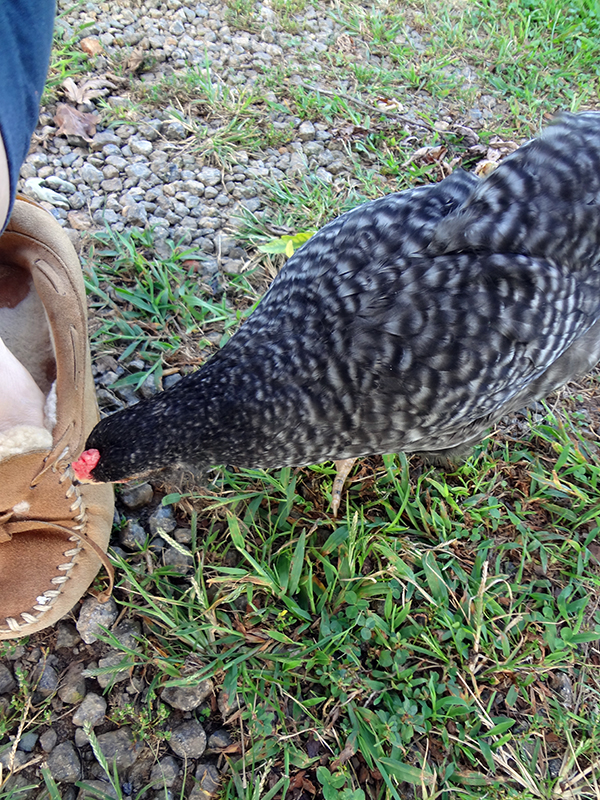
The white Coronation Sussex chick is, I believe, a pullet. Thank goodness. She is the sweetest of all six babies, always the first out of the coop and very amenable to being handled. Her lavender feathers are growing in around her head and tail, and I think she’s just so pretty. I have named her Calla.
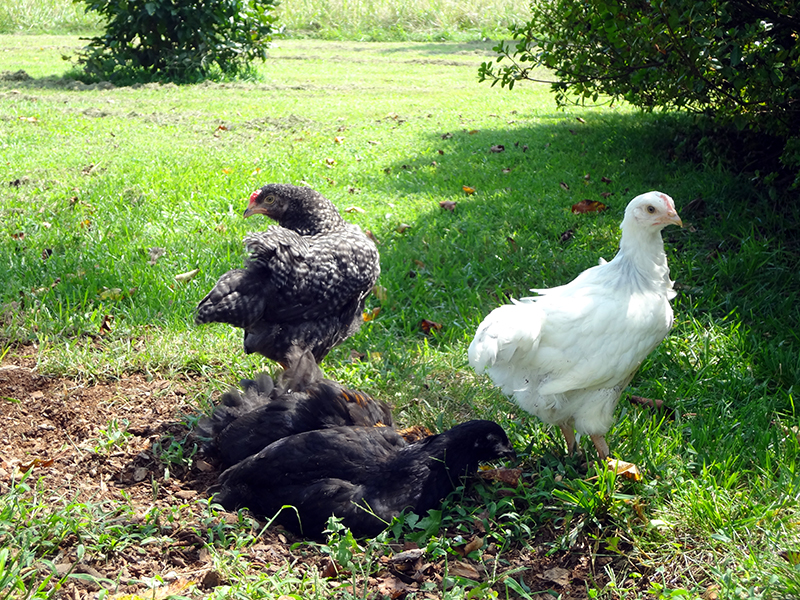
None of the other birds are named yet. I will have to see what comes to me. I also have to get Griz and the other young cockerel up on CraigsList soon. Hard to do because the birds are so cute right now—just perfect little mini chickens. But mini chickens will soon be full-blown roosters, and three on this farm is two too many.
The big chickens have met and mingled with the chicks. It’s gone okay, with the expected bullying as the older birds show the younger birds their place. Here’s Cora landing a squawk-inducing peck on a chick, while the other babies bunch up for safety and Griz tries to decide whether to be a man.
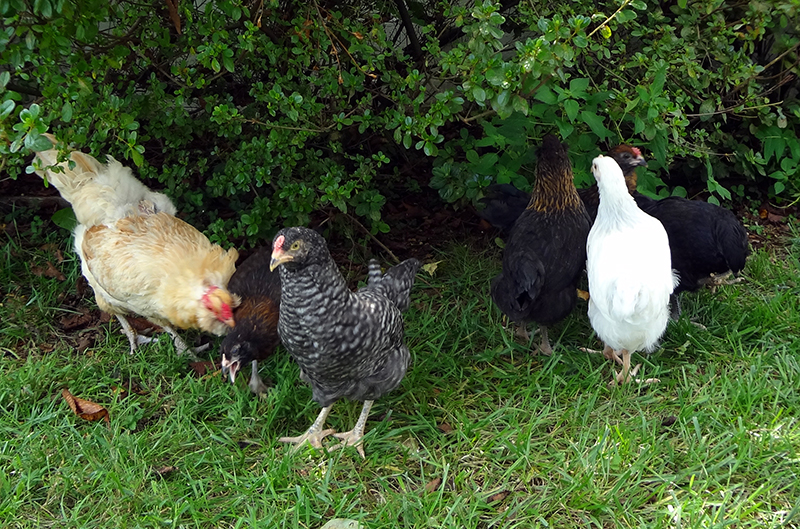
As of last night, Dahlia has rejoined her flock. It seems to be going okay for her. I bet she’s glad to be rid of these increasingly active babies in a small brooder coop.
Fifteen birds running around here is a lot, but I kind of love it. If chickens weren’t so messy, and their food so expensive, and if we didn’t have to go through winter when free-ranging isn’t as easy or safe, I would have zillions of chickens.
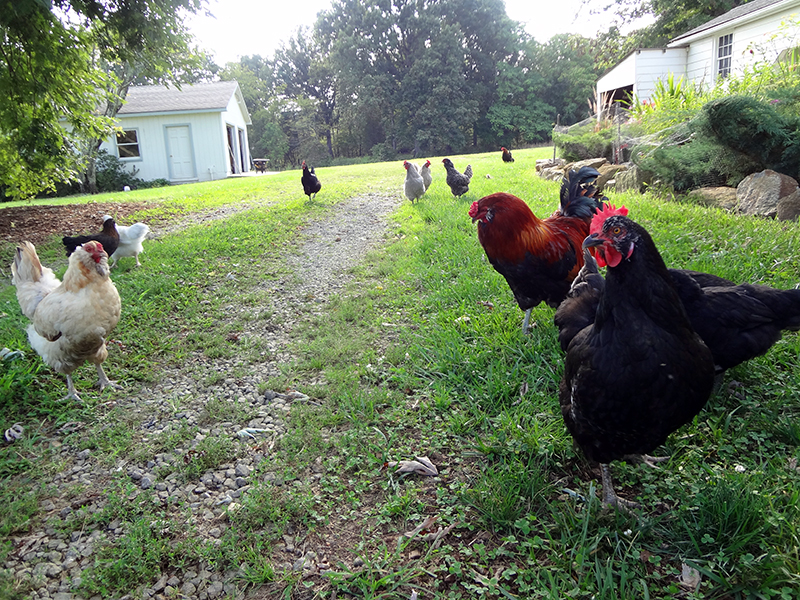
July 24th, 2013 §
The chicks are growing by the hour, and their new trick is to jump on Dahlia’s back and ride around a bit before sliding/flying off. She is amazingly patient with these constant assaults, which are probably way more cute to me than they are to her.
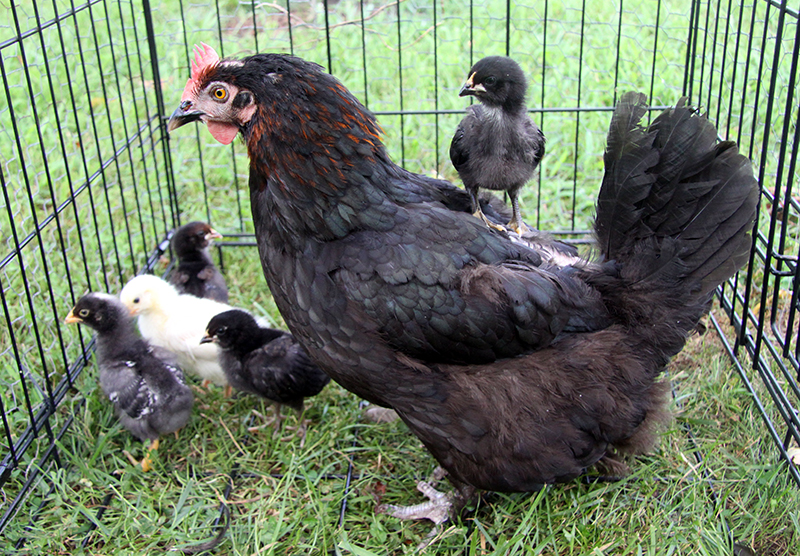



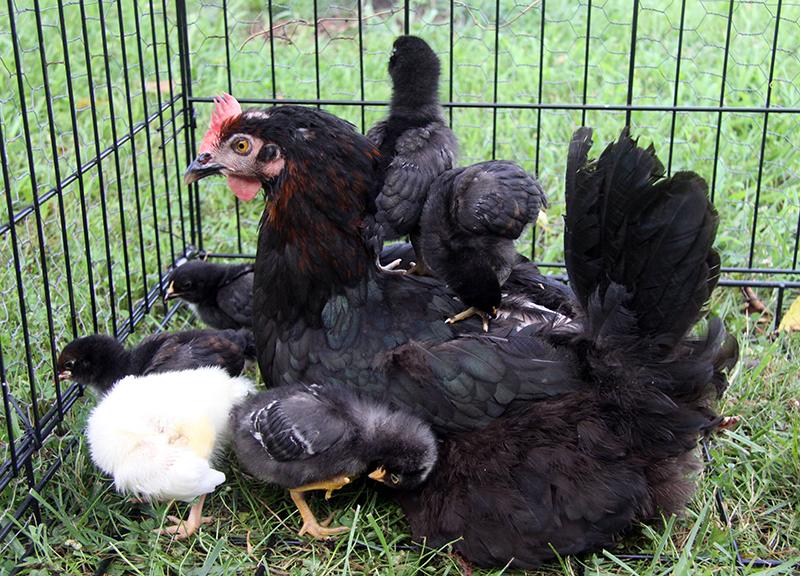
All this action shows me the chicks are ready for new adventures. On Saturday night I wrapped Tuckers’ puppy crate in chicken wire to make an escape-proof pen, and took the chicks outside for their first real exposure to grass and dirt. I’ve had then out every evening for a bit, and it’s neat to watch them learn how to scratch, hunt bugs, and eat clover. It’s amazing how much the chicks change and grow from day to day. Just two weeks old and they’re well on their way to being big chickens.
July 16th, 2013 §
Enough of bloody flock power struggles. Let’s talk about the happy family living in the broody coop in the garage. Dahlia is a very calm and patient mother, and protective. She flew out of the coop last night when I took one of her chicks out to hold and she heard its distress cries. She’s doing a great job with her six chicks. They’re growing and changing by the day, and are already feathering out. It’s exciting to see a lot of copper brown in the new feathers of the black olive-egger chicks.
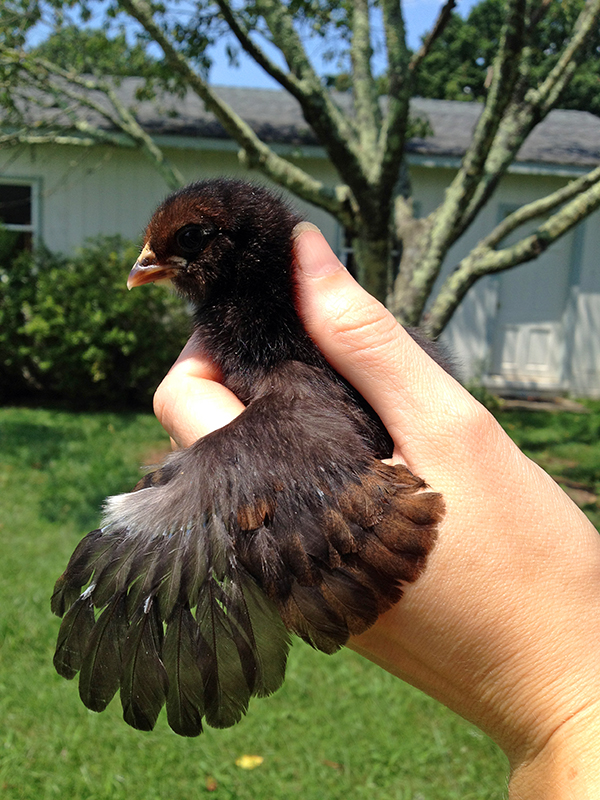
I am not sure if they will be any indication of the final coloration of the birds as adults, as coloration changes each time the chick molts. But it would be neat to have some brown hens—I don’t have any in the flock now.
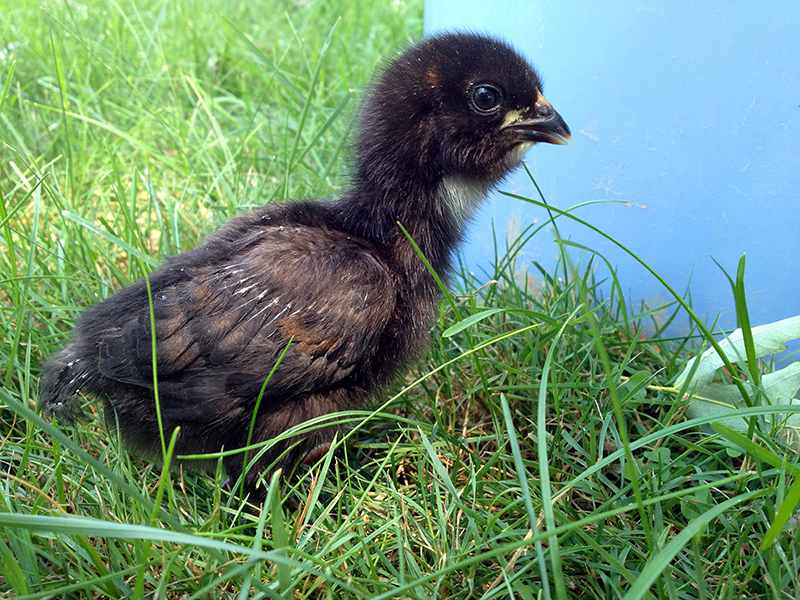
Some of the chicks still have their dried up umbilical cords attached. I never knew birds had umbilical cords until I saw them on the guineas that Iris hatched out last summer.
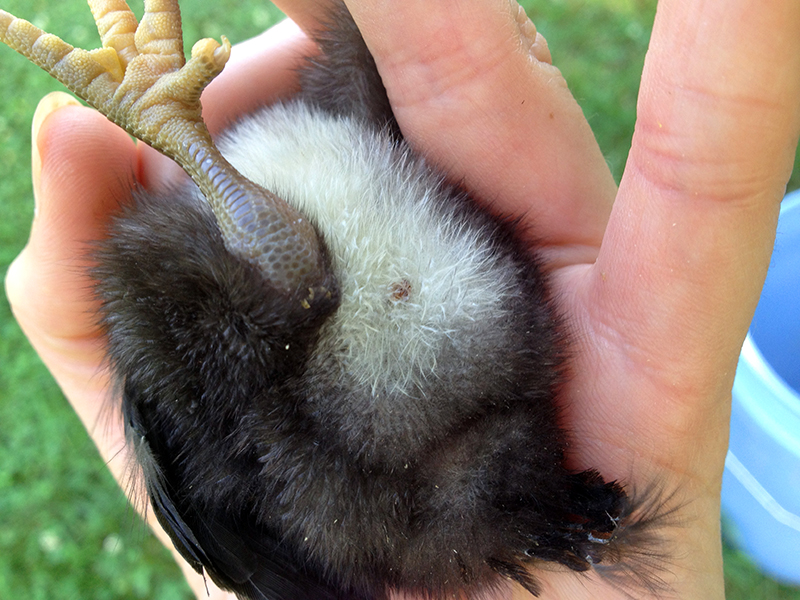
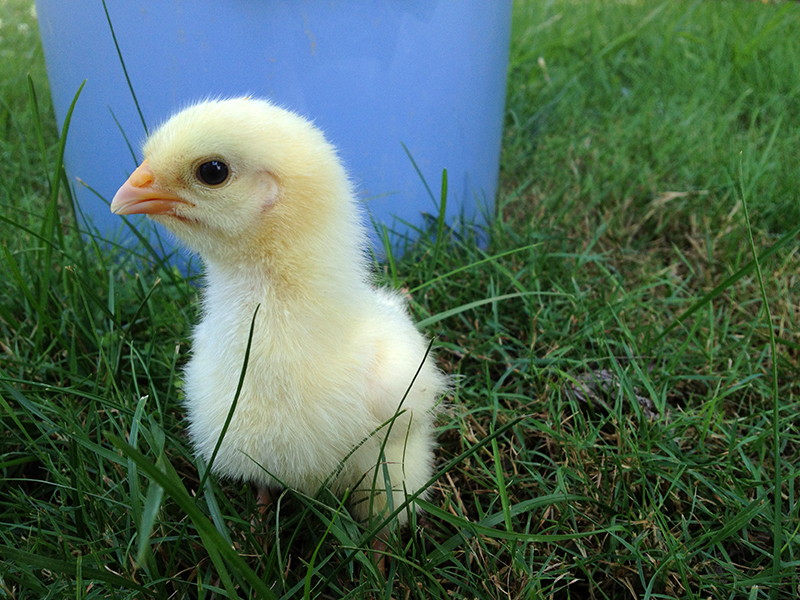
Here’s the sole Coronation Sussex chick. My $20 chicken (six hatching eggs cost $20, and this is the only bird I got out of them). Thankfully these birds are rare enough around here that if it’s a cockerel I should be able to sell him for at least $20.
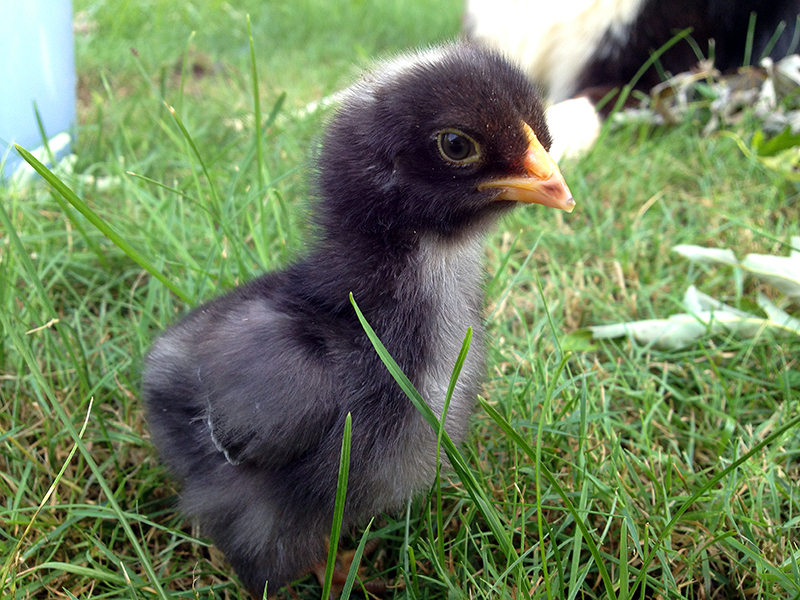
This is Griz, the only chick out of my barred olive egger Oregano and the chick whose egg survived car trips and refrigeration at my brother’s house. I let my brother name the chick. He picked Grizabella, but when the chick was born a boy the name got shortened to something more masculine. The white barring is just starting to show on his wing tips, and he’s got a bit of copper color to his head (which makes me think this coloration traveled in on my Wheaten Ameraucana rooster’s genes, as the black chicks have it too). But who knows!!? The neatest thing about making these breed crosses is seeing what they turn out to look like.
July 15th, 2013 §
On Saturday it was time to cull the deformed chick and move Oregano back in with the main flock. Two odious tasks I’d been dreading.
Before removing the two broody hens to their nursery coops, I had finally achieved a nice, stable and harmonious flock. The rooster was sweetly keeping order, and every bird was finally in good health, all wounds were healed and parasites eradicated. Things were going along well. However, whenever a chicken is added or subtracted from a flock, a power vacuum opens and each bird scrambles to attain the highest possible spot in the pecking order. The birds don’t “remember” a former flock mate, even if she was only out of the coop for a month. To all of them Oregano is a stranger, and their instinct is to kill her in order to preserve their own position in the flock.
So I know all this going in, thus the dread, and I tried a few things to see if I could smooth the transition. I put Oregano in the little run outside of the coop and released Calabrese, the rooster, from inside. I figured if he accepted Oregano back in to the flock he would perhaps help protect her from attack by the other hens, or they would see her as less of a threat if she had her baby-daddy on her side.
But when the two of them got together, this happened:
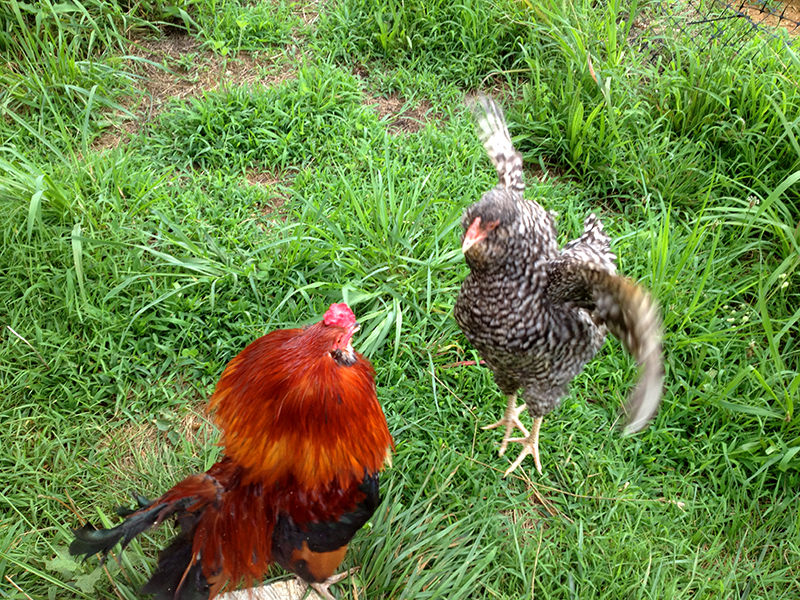
Then this:
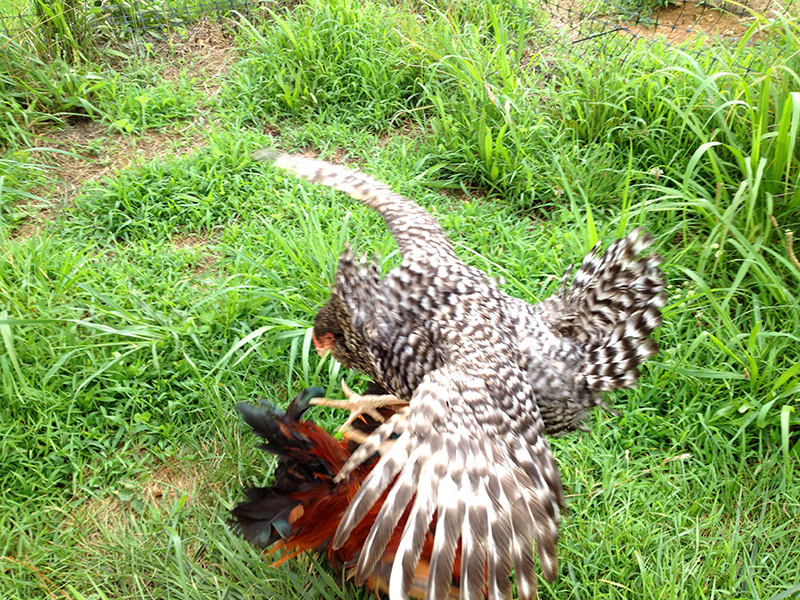
And this:
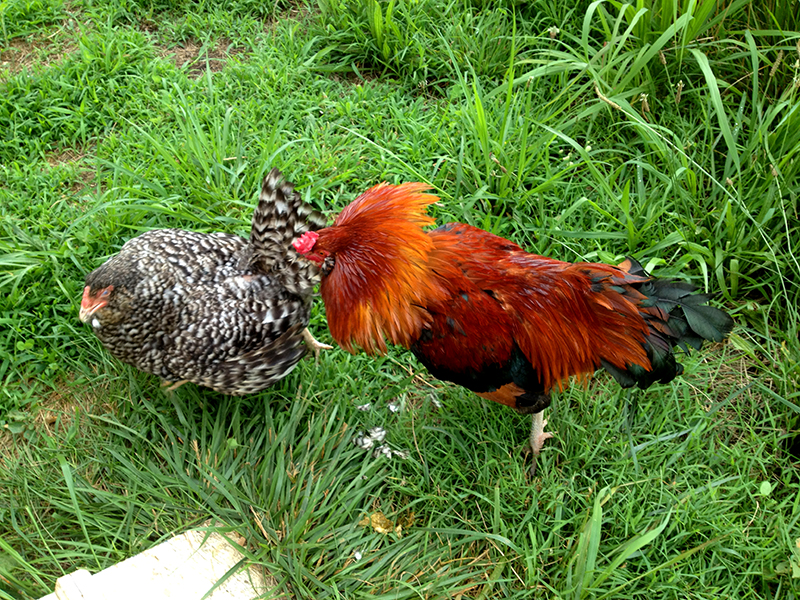
The birds went at each other in a dazzling display of spread feathers and clashing claws. Oregano puffed herself up as large as possible as she fended off Calabrese. Between attacks Calabrese “danced” for Oregano, so he was definitely conflicted about whether to fight or flirt with this “new” bird, with whom he had one biological offspring growing up in a nearby coop.
After things settled a bit I let the other hens out, one by one. Most hens ignored Oregano, and so I thought I was in the clear. So I released them all into the yard, hoping that some free ranging would give them something to occupy their thoughts and diffuse any potential conflicts. The flock ran out, and Oregano ran into the coop. She seemed grateful to be home again and started eating right away. Things seemed to be going okay.
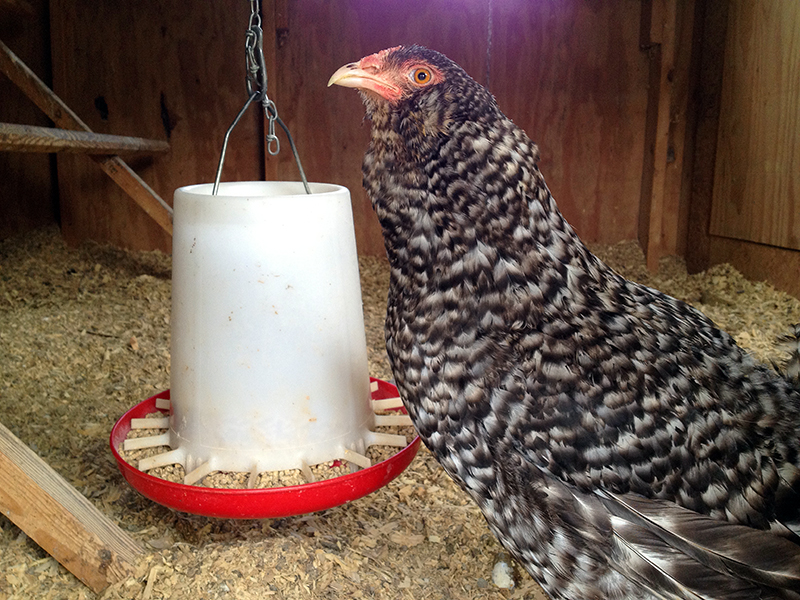
Then I went out in the evening and found the flock, minus Oregano, hanging out at the compost pile in the woods. Oregano was huddled under the fig by the garage, hiding. She had been shunned, and had to take shelter.
I called all the chickens back to the run behind the coop to force them to be together in a slightly smaller space. The hens took turns jabbing at Oregano’s head and she ran amongst them, head down and feathers fully puffed, looking like a football player lumbering down the field. It’s wasn’t peaceful but she seemed to be holding her own. And this was really her own battle to fight. There’s nothing I could do as they jousted.
Oregano spent the night sleeping in a nesting box—a good defensive position—with the other birds on the roosts. Sunday morning all seemed okay, but I had to go out of town for the day and was very nervous to leave the unstable flock cooped up all day. With no where to run, the confined area can be fatal (see Cora’s scalping and near-death experience last summer). But there wasn’t anything I could do as I had promised to go.
Last night I got home around seven and opened the coop immediately after parking the car. As I had feared, I found that Oregano had been attacked.
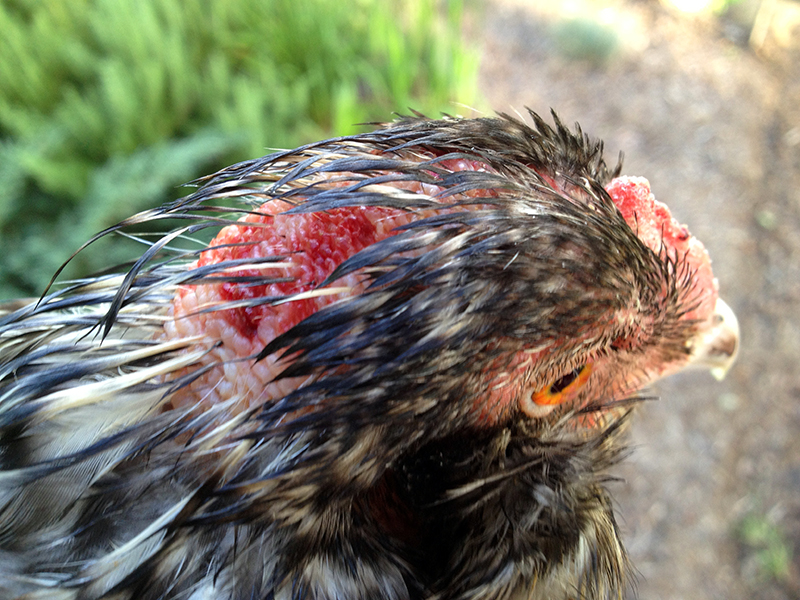
Her head and comb were torn open and bloody. So the first thing I did, before even letting my poor dog out to pee, was to grab Oregano and bring her inside for first aid. She didn’t even struggle.
Oregano got a Bactine cleansing, then a nice coat of Neosporin. I covered that with a thick layer of black salve, which supposedly tastes bad to attacking chickens. Over all that I sprayed Blu-Kote, a wound dressing. It masks the red blood color that encourages chickens to continue pecking. By the time she was done she looked a fright, but hopefully it would be enough to get her healed and keep the other birds off of her. The good news is that when I checked on the birds this afternoon Oregano didn’t seem to have suffered further injury, so hopefully her disguise is working.

This poor girl. All she wanted to do was have a family. And after a month of sacrificing her own health, she lost her chick, was turned on by her former flockmates, and suffered injury at their beaks. I wanted to raise chicks with broody hens, because it’s less work for me, but I am not sure if the tumultuous flock dynamics makes it worth it. I still have Dahlia to get incorporated back into the flock, and the six babies. Better get a bigger tube of Neosporin…
July 10th, 2013 §
There were no new babies born overnight, but around noon today I found a broken open Coronation Sussex egg. The embryo inside was well developed but still had a lot of yolk, so I know it wasn’t ready to be born. It was the egg that Dahlia chucked out of the nest on the first day of the hatch. Perhaps she did that because the embryo had died, or maybe it was out of the nest long enough to chill and stop developing. We’ll never know.
There was a Black Copper Marans egg in the process of hatching under Dahlia. It seemed to be struggling a bit, but I left it alone. When I came back hours later there was a new chick.
Once the chick had dried, I inspected it. Unfortunately it was born with a severe birth defect. It has only one eye, and its beak is misaligned.
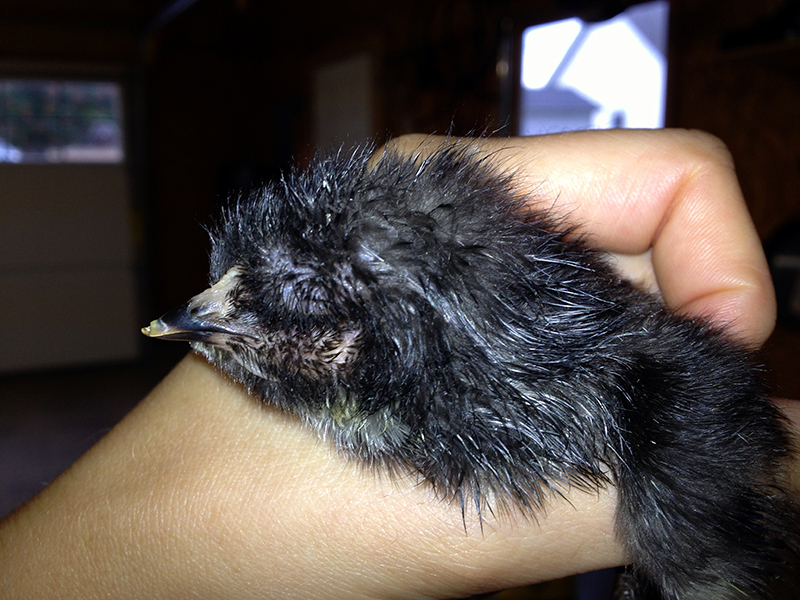
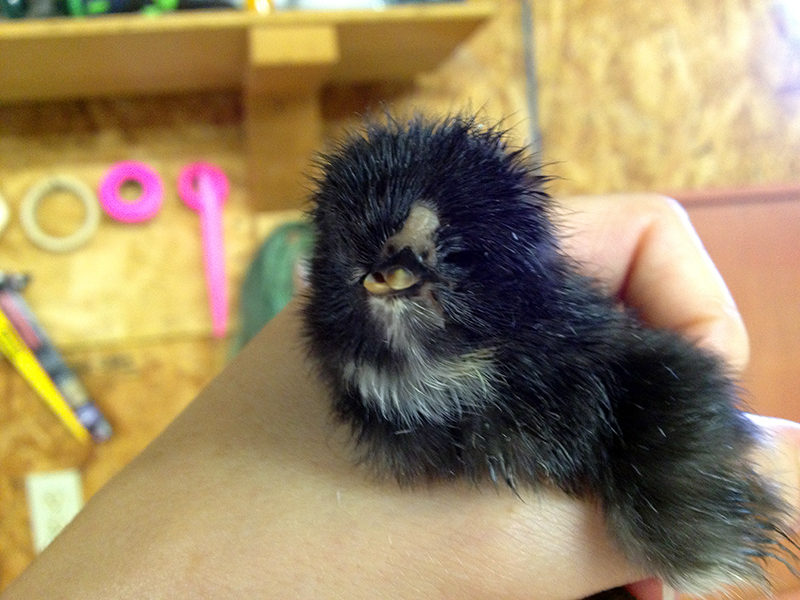
I suspect that there is no sight in its one eye, as it struggles to open that eye and doesn’t seem to respond to any visual stimuli.
I did some quick research and the prognosis isn’t good for a bird born with this defect. Some people can keep them alive with careful attention to making sure the bird gets enough to eat, but most people cull chicks born like this. That is what I plan to do.
The deformed chick, did, however, give me a good opportunity to get all six healthy chicks under Dahlia. I knew going into this that if I had just a few chicks, I would try to combine them under one hen. It didn’t make sense to double the work and cleanup of managing two coops of babies, and I knew that the older the birds got the more trouble I would have when it came time to combine both groups of babies. As I already know how potentially fraught introducing new birds to the main flock is, I wanted to minimize one extra step in the development of a new pecking order.
I chose to take the chicks away from Oregano because of the two birds, she seemed the less serious about mothering. She had pecked at the toes of the Coronation Sussex baby when it was brand-new, and today she was off the nest several times during the day, eating, drinking, and trying to dust bathe in the pine shavings. Not that one can blame her! Perhaps she knew the hatch was done and was trying to get her babies to follow her out to food and drink, but I didn’t get that sense from her.
I was stressed to put Oregano’s three chicks under Dahlia, but I did it one at a time and she didn’t bat an eye. The chicks dove right under her breast like they’d always been there, and there’s been no looking back. In fact, she led her babies off the nest this afternoon, leaving the deformed chick in the nest.
I took the unhatched eggs from Dahlia’s nest and added them to Oregano’s along with the deformed chick. I figured she’d go less crazy if she had a chick under her than if she had nothing and could hear chicks next door. But who knows, maybe she wouldn’t care? Anyway, the plan now is to give any remain eggs another day under Oregano to try to hatch, though I doubt any will, and then return Oregano to the main flock. Which might be tough if they see her as an intruder instead of a flock mate. Geez—managing these birds can really be a pain!
But if I get Oregano back with the flock, I should be in the clear. Dahlia can raise six chicks for as long as she likes, and I will deal with whatever comes next when it arrives. The good news is the six chicks now with Dahlia have spent the afternoon learning to eat and drink.
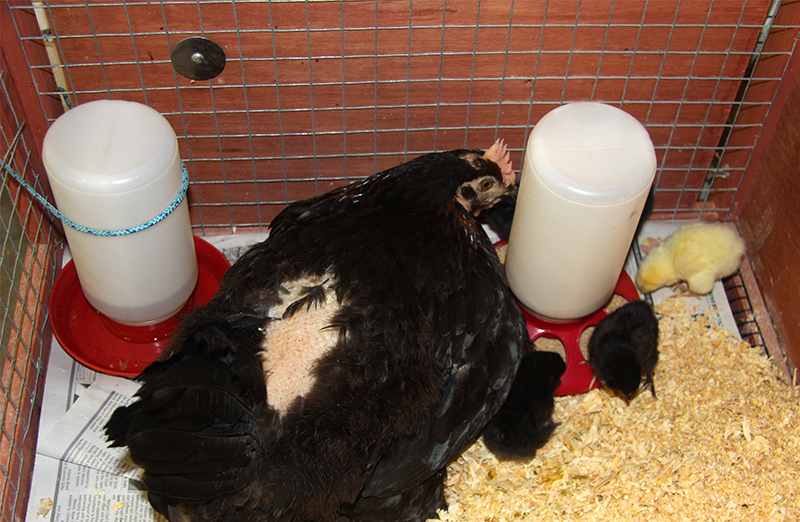
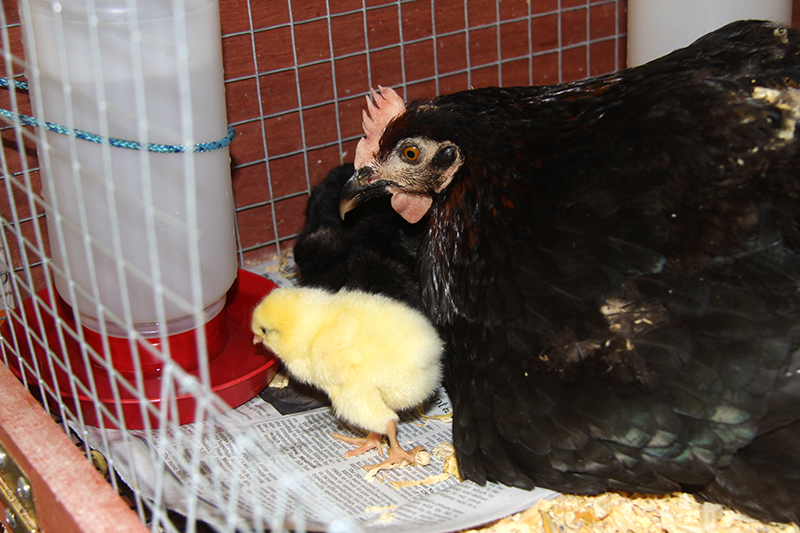
They are very active in the coop, pecking at everything including their mother’s comb (you can see a little blood spot in the photo above), wattles and even eyeballs, and seem healthy and happy. They run around, and when they are tired they dive into their mother’s feathers for a nap. Can you spot the stowaway?
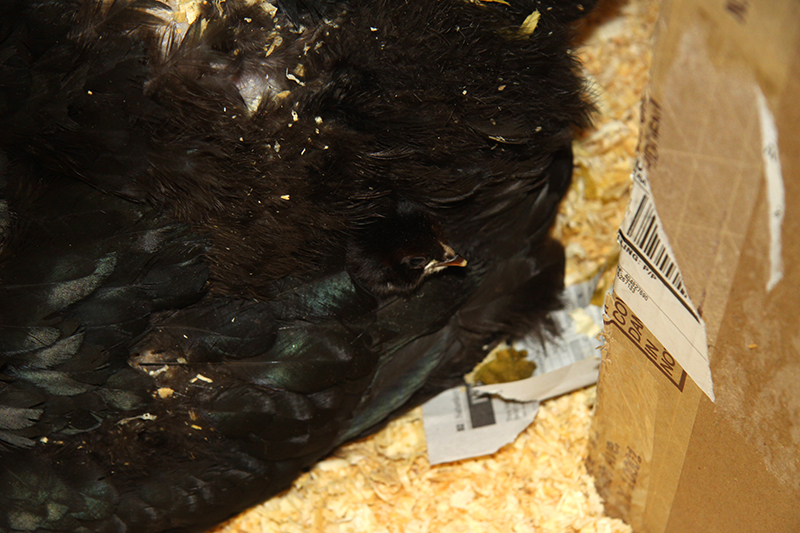
July 9th, 2013 §
There are new chicks, hatched early this evening, under both Dahlia and Oregano. Both are babies from Black Copper Marans eggs. Now each hen has three live babies, for a total of six on the ground. Oregano had one baby that pipped this evening, but it died before making it out of the shell. When I investigated, its yolk hadn’t yet been absorbed. I am starting to think the hot temperatures have affected this hatch, but that’s just a hunch and not substantiated yet with any research.

The chicks that were born last night are very active, hanging out at the front of the next box, pecking at shavings, and interacting with each other. Here are the yellow Coronation Sussex and the barred olive egger/wheaten Ameraucana boy.

They must be starting to think about food. Perhaps tomorrow they will take their first excursion out of the nest box. I am sure both mothers are also ready to get out of the nest. Notice how pale and dehydrated their combs and wattles are. Incubating eggs takes a lot out of a hen as they barely eat and drink just enough to keep from dying. They’ve both lost a bunch of weight—when I feel their chests all their breast muscle mass has shrunk away on either side of the keel bone.
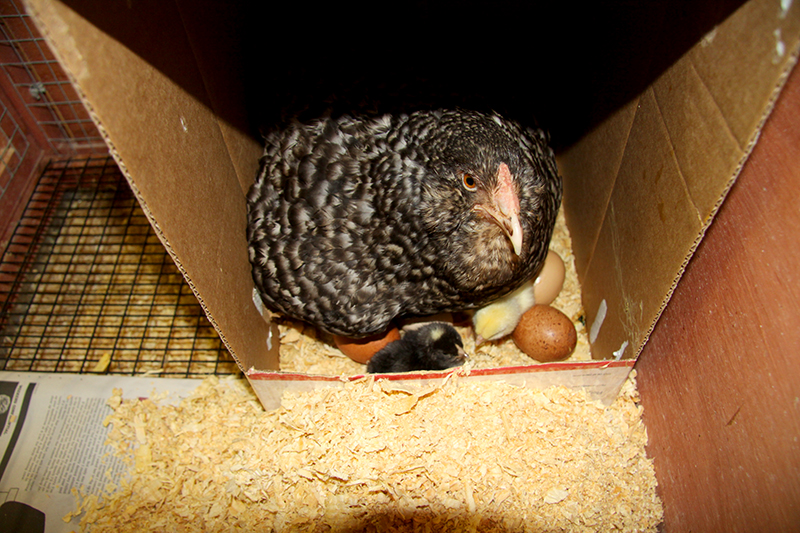
I find it interesting that when the guinea keets hatched last summer, they were way more active, way sooner than the chickens. The guinea keets were still wet from hatching and they’d already begun running out of the nest box. The chicks seem to be rather limp until they fluff up and find their legs. This little one under Dahlia has favored this front corner of the box all day. The chick has a few copper colored feathers, the same tone as mama’s, around its head and sides.
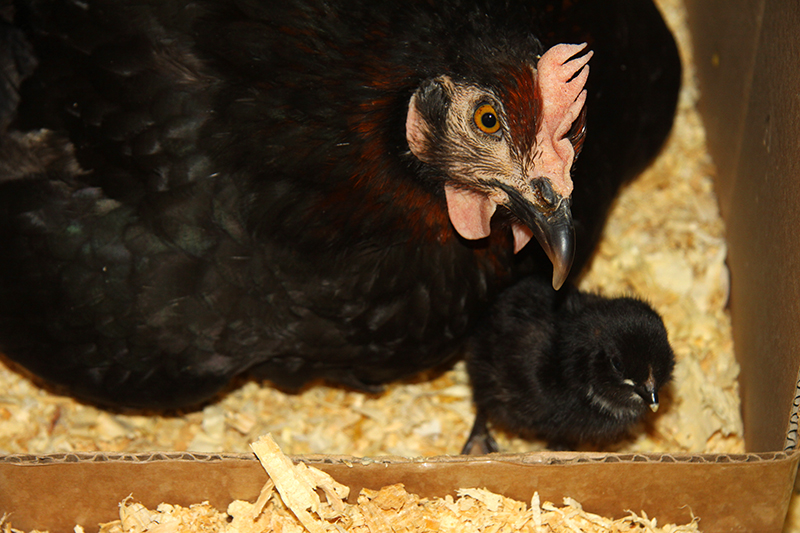
I suspect we might be done with this hatch. There aren’t any more pipped eggs, and nobody cheeped when I tapped on their shell. But we’ll see what the morning brings. I am ready to be done with this hatch phase, with its attendant death and stinky ooze, and on to seeing darling little fluff balls running all around the coop learning to be big chickens.
July 9th, 2013 §
At 8:00 a.m. I went out to check on the chicks. I heard peeping when I opened the garage door, so I knew there were babies somewhere!
Under Dahlia, two black chicks were just about all dried and fluffy. One came from a Black Copper Marans egg, which makes it an olive egger, and the other chick is Lilac’s baby. I saw one pipped egg but didn’t check them all.
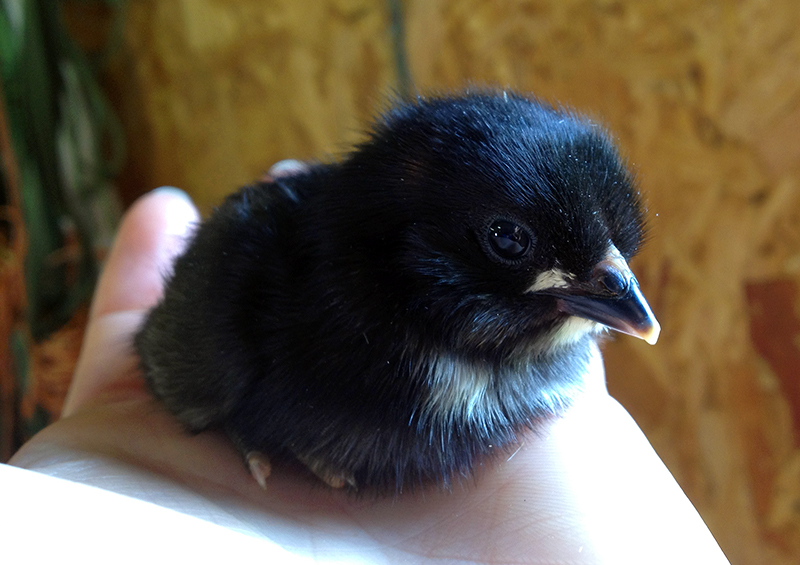
Under Oregano, the barred olive egger, there were two hatched chicks.
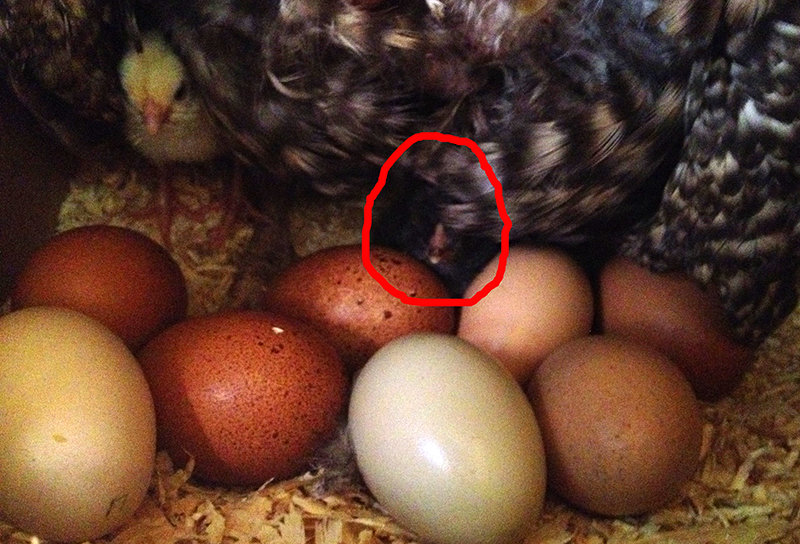
First up is a yellow Coronation Sussex baby!
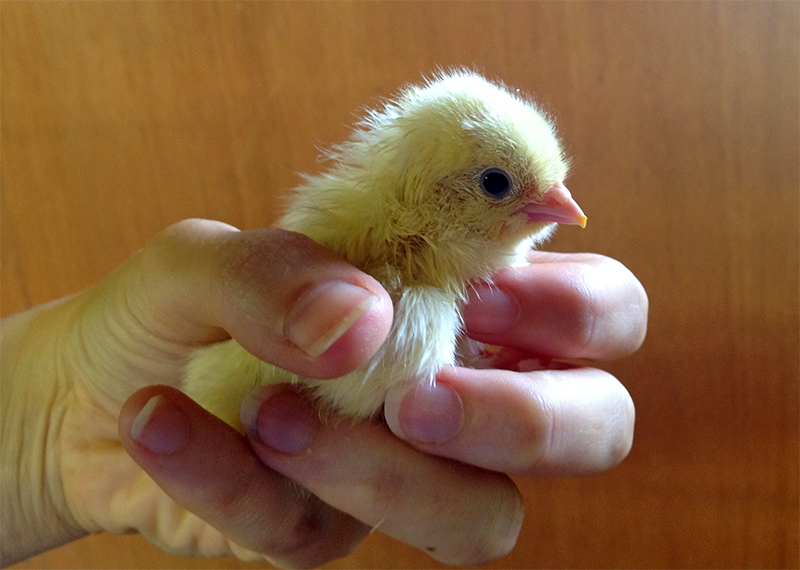
This is pretty exciting. And Oregano’s own egg, the one that journeyed to a Richmond refrigerator and back, had hatched during the night.
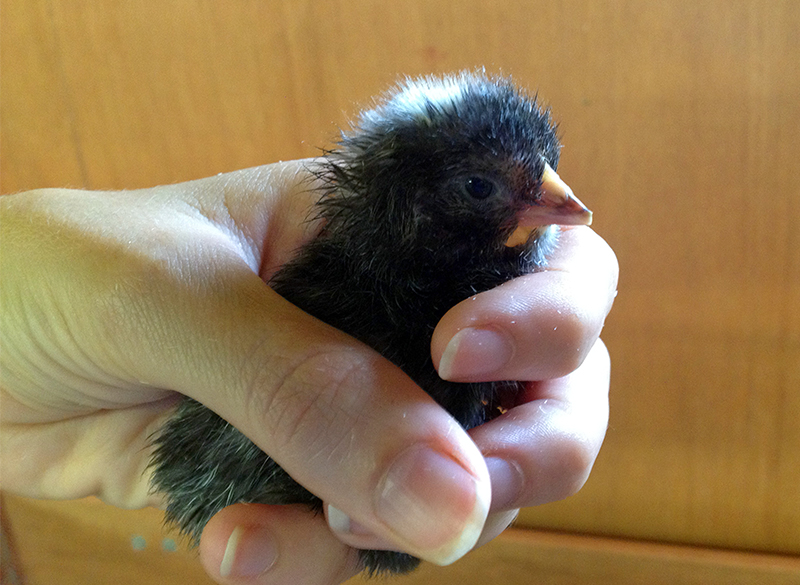
Unfortunately I think it’s a boy, as it has a white spot on its head, a sex-linked characteristic of barred breeds. Too bad I won’t get a chance at a super green egg layer this time around.
Meanwhile, here are the chicks’ empty eggshells. From top, the Coronation Sussex, then the barred olive egger, then Lilac’s egg, and finally a Black Copper Marans egg.
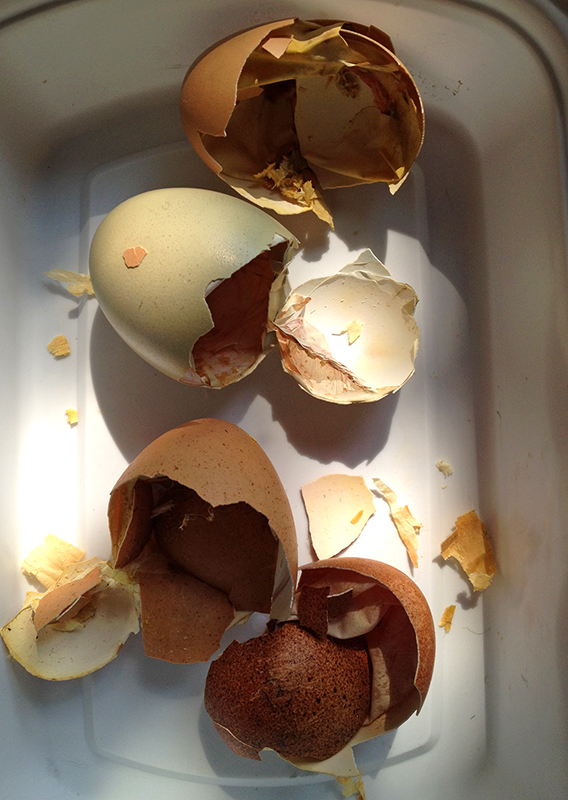
I saw another pipped egg in Oregano’s nest, so I left them in peace to continue hatching. There may be more babies to come, we’ll see.
July 8th, 2013 §
When I got Tuck in from his evening constitutional, around 10:30 p.m., I checked the nursery. There was a lot of action under Dahlia, lots of peeping and I saw a black chick partially emerged from its egg. Of course my phone battery was dead, so after it had charged up I headed back out, around 11:00 p.m., in hopes of getting a photo for you.

A chick! A real, live, healthy, vigorous chick! It obviously had a nice, quick, clean hatch, and was moving around like crazy. In the light of the flashlight, which I held in my mouth to take these photos, it bobbed and ducked and cheeped and burrowed deeper under Dahlia. She seemed to regard it with benign curiosity. Like, what is that? It’s a good thing she will have the whole dark night to get used to the idea of being a mother. Which she will be several times over, if the noises on her nest are any indication.
You can also see in the photo above the egg, on the right, that was pipped in my last post. Not too much development there.
Over in Oregano’s coop, it was much quieter. But, her egg, the olive egg, was definitely progressing. This is somewhat amazing as this is an egg that I put in a carton, carried in a warm car down to Richmond to give to my brother to eat, where it spent several days in a refridgerator before I realized Oregano had gone broody and ceased laying. This egg, and another that traveled with it, plus one I still had at home, were her only hope of biological offspring. So my brother carefully packaged the eggs for a return trip via my dad to Charlottesville, where I placed them back under their mother. One olive egg disappeared during incubation, and the other came up clear when I candled it. Thus I had zero expectation that through all this jostling, temperature change, etc., this egg would hatch, but here it is, tonight, with a peeping baby inside.

And here’s another egg, still pipping and making progress:

All eggs went immediately back under their mothers, and I came in to write this post before bed. I’d be lying if I said my heart didn’t stop seeing that healthy, wet baby under Dahlia. I am not the fainting type, but I felt lightheaded and swoony. I guess that’s what happens when you’re face to face with brand-new, much-hoped-for life. I could only imagine what it would feel like to see one’s human baby. If my reaction to new-born chickens is any indication, am not sure my heart would survive the crush of emotion.
I hope that the first check in the morning reveals nests full of fluffy, healthy, hungry chicks. That is my dream for tonight.
July 8th, 2013 §

Today is day 20 for the eggs that are incubating under the broody hens. Last night I discovered another broken rotten egg under Dahlia, the Black Copper Marans, and had to clean that up.
I check the nests this morning, just by listening for peeping, and heard nothing. Then tonight at 6:00 p.m. I went out and saw that Dahlia had thrown one of the remaining Coronation Sussex eggs (two others had already broken during incubation) out of the nest, most likely because she knows it’s not viable.
I heard very faint peeping and took a quick peep under Dahlia’s breast feathers. There I found this dead chick. It appears perfect (look at those toenails, that egg tooth, the cornsilk feathers) except in one vital way. It’s yolk is not entirely absorbed into its belly. Where there should be a clean, dry shell after a hatch this one is a mess of blood and yolk. And its eyes are still sealed shut. It appears that this baby came too early. Not sure why. Could be the hot temperatures, who knows? Perhaps Dahlia even killed it, as some first-time broodies will. I removed it from the nest, Dahlia pecking at it as I dug its sticky body out of the pine shavings.
It’s a sad way to begin the hatch, but beyond my control. By the way I am not posting photos here to gross anyone out. I am posting them because I find a ton of wonderfully educational information on blogs. What “ordinary people” write is often more relevant and specific than the information I find on formal educational sites (for example, the .edu party line is that chicken eggs hatch in 21 days. But because of reading blogs about other hatchers’ experiences, I learned that eggs under broody hens usually hatch on the evening of day 20. And here we are, hatching on the evening of day 20). I hope that by describing and photographing this hatch someone else may benefit from my experience or be able to leave a comment that educates me about how I can do something better in the future.
But back to the coops. There are still signs that more chicks are trying to hatch. Here’s a pipped Black Copper Marans egg.
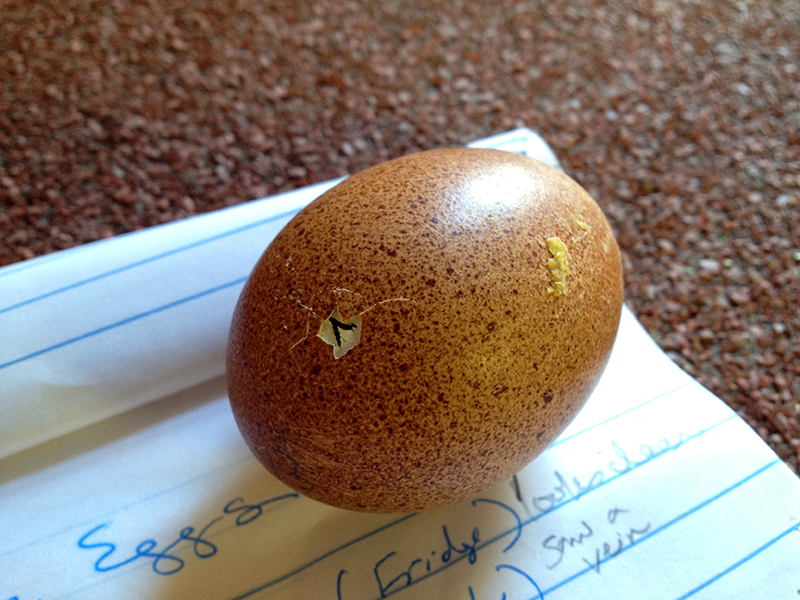
This chick is inside, faintly peeping, and I could feel and see it move through the hole. I put it quickly back under its mother and checked Oregano, the barred olive egger, very fast.

I could see under her feathers that two eggs had pipped, but I didn’t dig around exploring. Now isn’t the time to fuss anyone up, especially with one already dead hatchling, so I am going to leave them alone and hope that I wake up in the morning to some live babies.
June 17th, 2013 §
Ever since April I’ve been hoping one of my hens would go broody and hatch some chicks. Why? Because baby chicks are some of the things that make life worth living, of course. That and I am seriously curious to see what kind of crosses would result from my Wheaten Ameraucana rooster over Black Copper Marans, Lavender Orpingtons, a Barred Olive Egger, and whatever mix Lilac and Iris are (Black Australorps and Mottled Java, according to their breeder).* Iris and Lilac are in their second year of lay, and it’s good to have younger pullets coming along to take over egg-laying duties. And finally, now that I am free-ranging the birds outside most days, I anticipate that at some point I will have predator loss and don’t want to be caught out with not enough laying hens to keep eggs in the fridge.
A broody hen is a wonderful creature because she manages all the care, feeding, and warming of young chicks. If you have ever raised chicks, you know that it’s a big, messy job to monitor their brooder temperature, clean up after them, keep them safe from drafts and predators, and make sure they get enough to drink and eat. So I told myself that the only way I would raise chicks this year was if a hen did all the work for me!
Last year Iris went unbreakably broody and I ended up giving her a clutch of fertile guinea eggs. She brooded them in a dog crate in the garage and hatched out and raised nine guineas. Here’s one at several weeks old, posing for its CraigsList portrait:
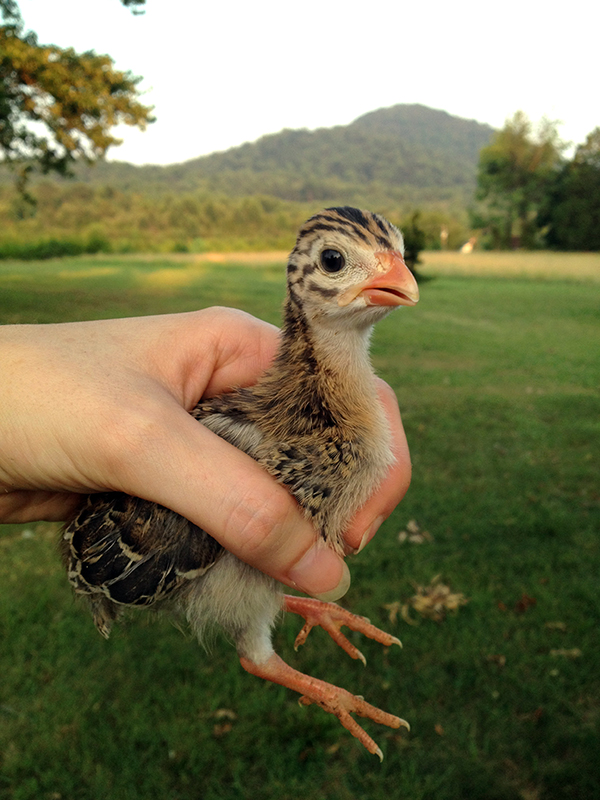
I got to watch the hatch and meet the still-damp keets, and it was one of the neatest days of my life. But this year, Iris has chosen to not do it again. Being trapped in a small cage with nine flighty, frantic, velociraptor-looking guinea keets was probably enough for her to sign off on motherhood forever. Not that I blame her—check out how those ravenous minidinosaurs are eying up their adopted mother’s toes while Iris pleads with her eyes for a Calgon moment.
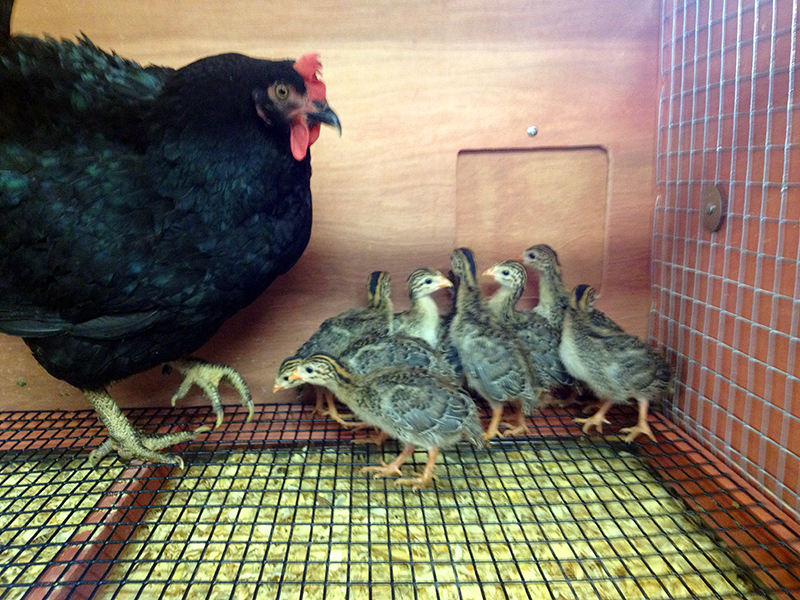
The most time-tested way to induce broodiness in a hen is to let eggs accumulate in the nest box. When the hen feels a growing clutch beneath her, some hormone switches in her brain that tells her to buckle down and brood. She will remain on the nest, barely eating and drinking, and will often pull feathers out of her breast so that she can keep the eggs tucked right next to her bare skin.
For weeks now I’ve been letting eggs accumulate, rotating out the older ones after a day or two in order to keep some in the fridge. I also placed the infamous glass eggs in the nests to trick the hens in to thinking there were always eggs waiting for a mother. And finally, it started to look like a few of then hens were beginning to feel broody.
Oregano, my beautiful barred olive egger, was the first to show any sort of devotion. After she’d been on the nest about a week, I fixed up a broody coop in the garage and built her a cardboard brood nest. It’s best to have a hen incubate eggs and raise chicks in a quiet, private place away from the bustle of the main coop, where flock mates may see new babies as tasty hors d’oeuvres. I was waiting for nightfall to move her to her new home when one of my Black Copper Marans saw the nest was exposed and jumped up to sit on the eggs.
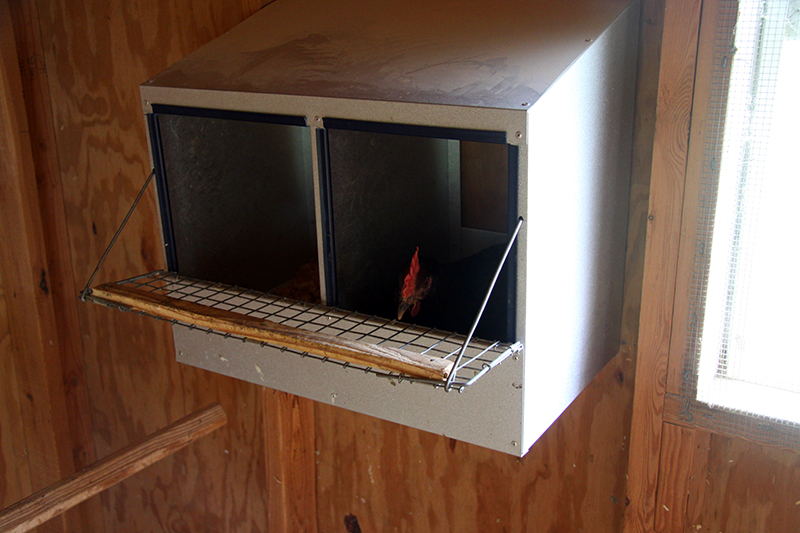
After dark, when I went to collect Oregano, the Black Copper Marans was still sitting tight on the eggs. One look and I got her message: She wanted a clutch of her own.
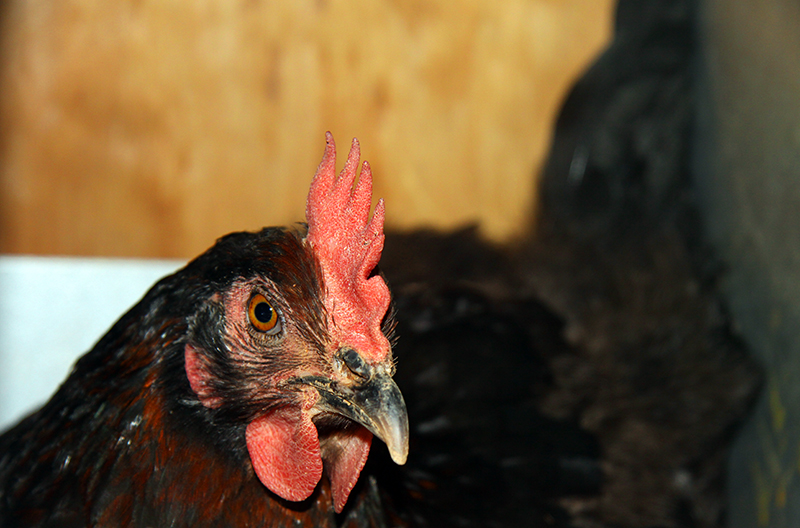
Oregano had assumed a broody position in the adjoining nest box. So I grabbed her and moved her and the eggs into the garage coop.

Oregano accepted her new nest and has stayed on it since Friday.
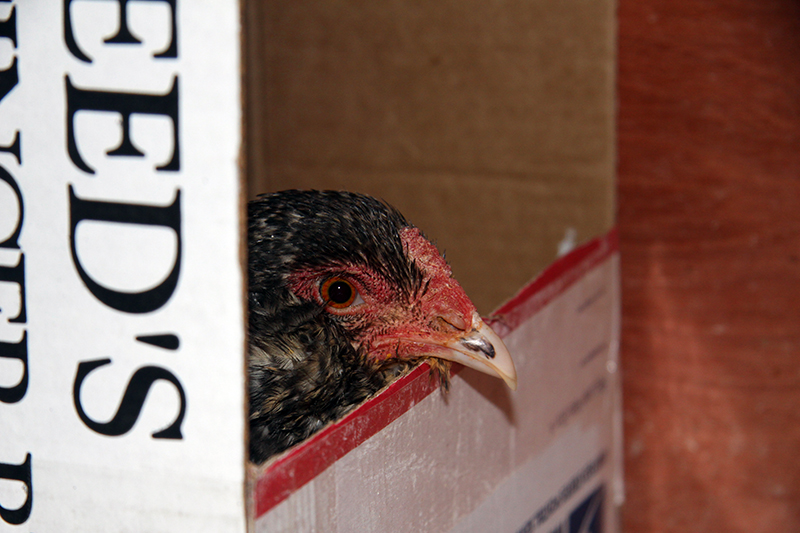
But the Black Copper Marans was still sitting on the glass eggs. And so I fixed up a second broody coop in the garage, built another cardboard next box, and last night moved her into a brood cage next to Oregano. So now I have two broody hens.
I have been saving out eggs for a week or so now, and when I get numbers I am satisfied with I will remove the glass and sacrificial eggs from under the hens and replace them with these fresh eggs. That way all embryos will start to develop at once, and all chicks will hatch at the same time. It’s a bit sad as the eggs are developing under Oregano, but their job really is to just “hold” the hen in a broody mindset until the more valuable eggs are introduced.
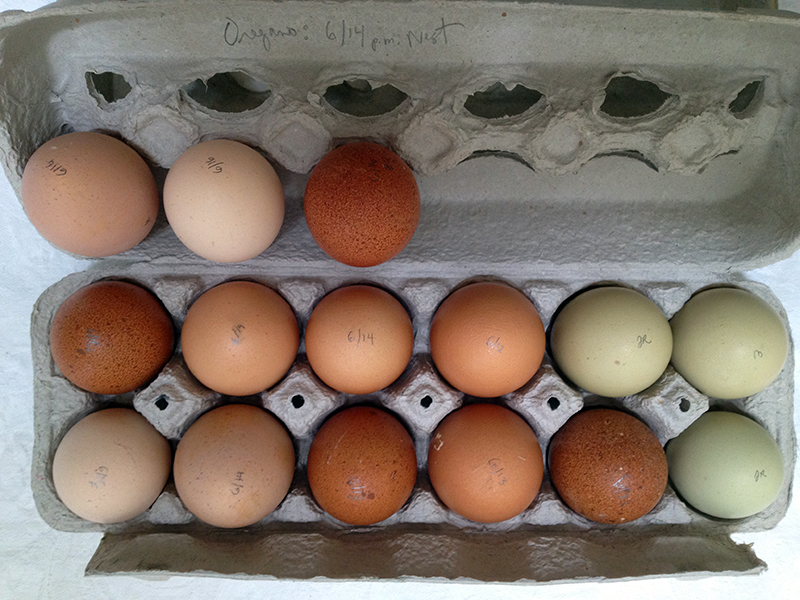
I wasn’t really planning on trying to raise two clutches, but at the end of the day it’s not such a bad thing. It means I can hatch more eggs, which is good as there is no way of knowing what the fertility rate is amongst my hens’ eggs. And, if one of the hens begins incubating and gives up, I could move the most valuable eggs to the other hen and have her take over. Thus, I am waiting until the same night to give both hens their eggs, and then we will see what happens! There is still a lot that can go wrong in the 21 days it takes to cook a chick, but I am having fun working with my broodies. If you’d like to know more, allow me to refer you to this excellent article by my favorite author on all things chicken, Harvey Ussery: Working with Broody Hens.
*A quick digression on chicken breeds and egg color: I have the right set-up to produce olive eggers, which, as their name suggests, lay olive colored eggs. To make a nice olive egger, you need a dark brown egg-laying breed (such as Black Copper Marans) mixed with a blue egg laying breed (Wheaten Ameraucana—my rooster). My Black Copper Marans don’t lay very dark eggs and I have no idea what sort of blue egg genetics my rooster carries, so I don’t suspect I will break any records with any pullets I hatch from that combination. But at the very least, I should end up with some sort of green egg, which is plenty exciting to me.
Now here is where it gets interesting. I have three eggs saved out from Oregano, my barred olive egger (the green eggs in the photo above). She does lay a very nice olive-colored egg, when she lays. By crossing her with Calabrese, and his blue egg genes, I may end up with a pullet that lays a really green egg, as opposed to an olive egg. But who knows, really? I have read about chicken genetics until I fell over from confusion and still am not sure what will happen. Mostly because I know nothing about the genetics of the birds I am starting with, other than their supposed breeds and what color eggs the hens lay now. And there’s always the possibility that I will hatch 100% cockerels and then the whole experiment is good for nothing but the freezer. And even if I do hatch pullets, it will be another year until they lay and who knows if I will even be in to chickens then!

















































